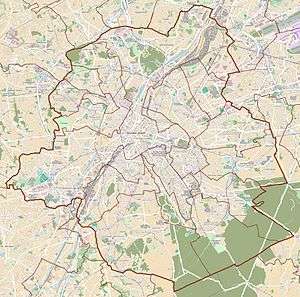Brussels City Museum
The Brussels City Museum (French: Musée de la ville de Bruxelles, Dutch: Museum van de Stad Brussel) is a museum on the Grand Place of Brussels, Belgium. It is dedicated to the history and folklore of the City of Brussels from its foundation to modern times, which it presents through paintings, sculptures, tapestries, engravings, photos and models, including a notable scale-representation of the town during the Middle Ages.[1]
_Brussels_City_Museum_Aug_2009.jpg) The Maison du Roi/Broodhuis building housing the museum | |
 Location within Brussels | |
| Established | 1887 |
|---|---|
| Location | Grand Place City of Brussels, Brussels-Capital Region, Belgium |
| Coordinates | 50.846961°N 4.35277°E |
| Type | History museum |
| Owner | City of Brussels |
| Website | Official website |
Conceived in 1860 and inaugurated in 1887, the museum is situated opposite Brussels' Town Hall, in the Maison du Roi ("King's House") or Broodhuis ("Bread hall"). The building, in the Gothic Revival style, is listed as a UNESCO World Heritage Site, as part of the square.[2][3]
History
Brussels' Town Hall was erected in stages between 1401 and 1455 on the south side of the Grand Place, and made the square the seat of municipal power. To counter this, from 1504 to 1536, the Duke of Brabant ordered the construction of a large Flamboyant edifice across from the city hall as a symbol of ducal power.[4] It was built on the site of the first cloth and bread markets, which were no longer in use, and it became known as the King's House (Middle Dutch: 's Conincxhuys), although no king has ever lived there. It is currently known as the Maison du Roi ("King's House") in French, though in Dutch it continues to be called the Broodhuis ("Bread hall"), after the market whose place it took.
The King's House was rebuilt after suffering extensive damage from the bombardment of Brussels by French troops in 1695.[4] A second restoration followed in 1767. It was reconstructed once again in its current neo-Gothic form by architect Victor Jamaer in 1868.[2] Jamaer built two galleries and a central tower. He also adorned the facade with statues and other decorations. At the back, he added a new, much more sober wing in Flemish neo-Renaissance style. The museum was opened in 1887 on the second floor of the building.[5] The new King's House was officially inaugurated in 1896.
In 1936, the building was designated a historic site at the same time as the Town Hall,[6] and in 1998 a UNESCO World Heritage Site with the rest of the Grand Place.[3]
Highlights
The Brussels City Museum features more than 7,000 items, including artifacts, paintings and tapestries from Brussels' history.[7] There are two dioramas of the city of Brussels in its early days and as it began to flourish in the 1500s. The museum's painting collections include works by Flemish Primitive Aert van den Bossche (15th century), and French historical painter Charles Meynier (18th century). The original statue of Manneken Pis is exposed on the top floor. Many items of the statue's wardrobe, consisting of around one thousand different costumes, could also be viewed in a permanent exhibition inside the museum until February 2017, when a specially designed museum, called Garderobe MannekenPis, opened its doors nearby at 19, rue du Chêne/Eikstraat.[8]
The City Museum is open every day except Mondays from 10 a.m. to 5 p.m. On the first Sunday of every month admission to the museum is free.[5]
(2).jpg) Martyrdom of Saints Crispin and Crispinian, Van den Bossche (1490)
Martyrdom of Saints Crispin and Crispinian, Van den Bossche (1490).jpg)
 Bonaparte premier consul, Meynier (1804)
Bonaparte premier consul, Meynier (1804)
References
- Staff writer (2013). "Museum of the City of Brussels". Museums of the City. City of Brussels. Retrieved 2013-04-09.
- Staff writer (2011). "Museum of Brussels City (Musée de la Ville de Bruxelles)". Museums. Brussels.info. Retrieved 2013-04-09.
- Centre, UNESCO World Heritage. "La Grand-Place, Brussels". UNESCO World Heritage Centre. Retrieved 2019-05-30.
- "History of the Grand Place of Brussels". Commune Libre de l'Îlot Sacré. Retrieved August 25, 2009.
- "Présentation - Brussels City Museum". www.brusselscitymuseum.brussels (in French). Retrieved 2019-05-30.
- "Bruxelles Pentagone - Maison du Roi - Grand-Place 29". www.irismonument.be. Retrieved 2019-05-12.
- Fun, Everything is (2017-03-10). "Brussels City Museum". Brussels Museums. Retrieved 2019-05-30.
- "New Brussels museum displays costumes of Manneken Pis statue". Reuters. 2017-02-03. Retrieved 2019-05-30.